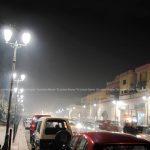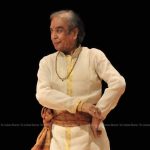Charbagh – 100 Year Story of Charm & Nostalgia
Lucknow Hum Par Fida Hai Hum Fida-e Lucknow,
Kya Hai Taaqat Aasmaan Ki Jo Chhuraae Lucknow

Charbagh is considered as one of the most beautiful railway station in India. Infact it is much more than a railway station, it is a blend of beautiful architecture along with an institution capturing a history of a century. It is the main railway station of the city of Nawabs whose structural designs never fails to charm any of its visitors. The building is designed as an amalgamation of Indo- British style of architecture by J.H. Horniman. Painted in red and white, this splendid structure looks like a Rajput palace from outside and from the sky it partially appears like a chess board with each of its turrets and domes that look like the chess pieces. The most striking feature in the designs of this railway station is that water reservoirs are so beautifully hidden inside the facade being covered by curves. It is said that the architectural style of this station is so amazing that makes it nearly impossible for anyone standing outside the station to hear the sounds of the incoming or outgoing trains.
Foundation of this building was laid on 21st March, 1914 by Bishop George Herbert and it was later in 1923 when it got re- constructed. This railway station was built at the cost of around 60-70 lakh rupees, which was quite an expensive amount in those days. On 1st August, 1925 C.L. Colvin, the agent of East India Railway laid inside the turret of the same building, a casket containing a coin of those times and a newspaper of the same day as a call to remembrance of the successful completion of the foundation of the building. An old railway engine is standing near the exit gate of the Khamman Peer Baba Mazar, recalling us the days of steam engine !
Eik Lutf-e Khaas Dil Ko Teri Aarzoo Mein Hai,
Allah Jaane Kitni Kashish Lucknow Mein Hai
It is the same place where Gandhiji first met Jawahar Lal Nehru and from 26th December 1916 to 30th December 1916 he took part in the opening session of legislature of Congress which was held at Charbagh Railway station and placed his proposal of putting an end to the sending of Indian labours abroad. It was again during the months of March-April in the year 1936 when Mahatma Gandhi came to Lucknow for the second time in order to attend another session of Congress Legislature, states Mr. Roshan Taqui, an eminent Historian of Awadh.
Although, the city has other railway stations also like Aishbagh, Alamnagar, Amausi, Badshah Nagar, City Station, Daliganj, Gomti Nagar, Jigaur, Kakori, Malhour, Malihabad, Manak Nagar, Mohibullapur, Utretia; but the nostalgia is associated with the Charbagh station only.

Most of the tourists miss the shrine of Khamman Peer Baba in their travel plan, it is also very less promoted by the writers and historians. It is more than 900 year old and the final resting place of Shah Syed Qayamuddin. Railway tracks on both the sides later on confirmed the strong existence of the shrine, as the British have planned to relocate the structure. Architecture is very beautiful and the campus also includes a mosque. It is a symbol of faith for every religion as people from all walks of life assemble here. Colourful, golden edged Chadars are sold outside the shrine, which devotees have been offering for centuries as a mark of respect and thanksgiving to the Peer Saheb. It’s a quiet place on days other than Thursday, and a stark contrast to the busy railway station and the trains bustling outside its walls.
Lucknow is known for its Ganga – Jamuni Tehzeeb, so how come Charbagh be left on this aspect. Famous Hanuman Temple is just outside the main building which attracts large number of devotees. Another unique aspect which is associated with this temple is ‘Monkey-Man’ which is found here. If you can recall the movie Delhi-6 and the story of the man inside the monkey, here you can find him live ! It is a dying tradition which has to be preserved at any cost.
Mehka Hua Hai Humse Gulistaan-e Lucknow,
Hai Jaan Hamari Lucknow Hum Jaan-e Lucknow

‘LKO’ is the short code of Lucknow used everywhere, have we thought anytime as from where it is derived. Yes, it if from the Lucknow Charbagh Railway Station which is operated by Lucknow Division of Northern Railway. It is also the main hub for the Lucknow – Kanpur Suburban Railway System (MEMU). On 23rd April 1867, the 47 mile Lucknow – Kanpur section was opened for traffic. LKO has nine platforms. As of 20th July 2014, more than 230 trains and 28 Slow Passenger Trains started from, terminated at or passed through LKO station.
The adjacent and almost contiguous railway station, officially known as Lucknow Junction Railway Station or Lucknow Jn NER (station code LJN), is also part of Charbagh Railway Station. Colloquially, it is known as ‘Chhoti Line’, historically it harboured NE Railways’ Meter Gauge trains of erstwhile Izzatnagar Division, now falls under Lucknow Division of NE Railway. It is the terminus station for broad gauge trains of North Eastern Railway just like Howrah, Chennai Central and Mumbai CST. Therefore trains that enter this station have to reverse their direction to get out of the station even if the train’s destination is beyond Lucknow. It is a separate building, with a distinct identity with red sandstone, but almost a continuation of the main LKO (Northern Railways) station building. Lucknow JN or LJN station has six platforms. The platform no.6 is accessible to the two wheelers, auto rickshaws and cars through an underpass cabway. This cabway is third cabway of Indian Railway after Howrah and Gorakhpur railway stations. As of 13th January 2013, 44 express trains and 10 slow passenger trains started from, terminated at or passed through LJN station. Earlier Lucknow junction was the terminus for metre gauge trains as almost all tracks of North Eastern Railway zone were metre gauge. With the conversion of most of these tracks to 1676 mm broad gauge under project Unigauge, the Lucknow junction does not have any metre gauge tracks. Now the terminus for the remaining metre gauge trains is Lucknow Aishbagh junction (station code ASH).
Tehzeeb Koi Meri Nazar Mein Jachegi Kya,
Meri Nigaah-e Shauq Ne Dekha Hai Lucknow

Charbagh is the heart of city in terms of public transport. Auto connectivity is assured with respect to every major corner of Lucknow. Nearby Alambagh serve as major Bus Station from where all nearby cities are being connected. Adjoining areas developed with hotels of all standards to cater the needs of everyone. With the passage of time and growing population, there are series of issues that have popped up and need immediate attention to keep the area glorified:
>> Proper traffic system is the need and concrete steps are required to make the entire region as congestion free in wake of the sprawling vendors, transport mafias and the nexus of unauthorized vendors.
>> Underground parking is must in view of the growing vehicles. The best spot is the front lawn of the railway station. The upper part of the structure can be made a multi-purpose restaurant along with small shopping mall & entertainment zone so that passengers who have to wait can utilize their time over there. The lower part should have underground multi-level parking. It will add to the beauty and the convenience of the people.
>> Cleanliness is another major problem which is missing in the railway station. Both the outside and inside areas have to be clean in all senses. Some time back, a drive was initiated by few volunteers with support of Times of India under I Lead India project. The result was encouraging but it could not be made an integral part of the cleanliness requirements. Escalators and lifts should be installed at every platform. We are in 21st century and coolies are still carrying tones of load on their head, this is very inhuman and should be stopped now. Proper substitute of jobs to coolies must be provided. When a mall can do the same, why cannot a railway station, where it is required most ?
>> The upcoming metro project poses a new challenge to Charbagh to keep its grandeur healthy. It is expected that the footover bridge which was constructed recently will be removed. Other than providing ease to the people who are crossing the front road; it provided a platform for the people to click good photographs of Charbagh which was not possible before. Metro station and the connectivity with Charbagh has to be very efficient and graceful.
Existence of Charbagh was there prior to the railway station also, but for the four gardens as suggested from the name too. It was beautiful garden developed by the Nawabs and subsequently changed to railway station by the British. New avatar brought a new life and a punchline “Muskuraiye Ki Aap Lucknow Mein Hain” is being linked with here. Few years back, it was installed on big frame and was visible to everyone coming outside the station…just before the portico, usually known as First Class entrance. Can we request the railway authorities to re-install the same as it is now a motto of Lucknow !
Woh Pyar Woh Khuloos Woh Mehmaan Nawaziya’n,
Lautey Jo Lucknow Se To Aankehin Baras Padee’n

Charbagh Railway Station
RAAT AUR RAIL
Asrar-ul Haq Majaz ( 1933 )
Phir Chali Hai Rail Station Se Lehraati Hui,
Neem Shab Ki Khamoshi Mein Zer-e Lab Gaati Hui
Dagmagaati, Jhoomti, Seeti Bajati, Khelti,
Waadi-o Kohsaar Ki Thandi Hawa Khaati Hui
Tez Jhonko Mein Woh Cham Cham Ka Surood Dilnashein,
Aandhiyo Mein Meena Barasne Ki Sada Aati Hui
Jaise Maujo Ka Tarannum, Jaise Jal Paryo Ke Geet,
Eik Ek Lae Mein Hazaro Hazaro Zamzame Gaati Hui
Nau Nihalo Ko Sunati Meethi Meethi Lorian,
Naazneino Ko Sunehre Khwab Dikhlati Hui
Naaz Se Har Mod Par Khaati Hui Sau Peench-o Kham,
Ek Dulhan Apni Ada Se Aap Sharmaati Hui
Muntashir Kar Ke Faza Mein Jabeja Chingaarian,
Daaman-e Mauj-e Hawa Mein Phool Barsaati Hui
Seena-e Kohsaar Par Chadhti Hui Be Ikhtiyaar,
Eik Nagin Jis Tarah Masti Mein Lehraati Hui
Eik Pahadi Par Dikhati Aabsharo Ki Jhalak,
Eik Bayabaan Mein Chiraag-e Toor Dikhlati Hui
Rengti, Mudti, Machalti, Tilmilaati, Haanpti,
Apne Dil Ki Aatish-e Pinhaa Ko bhadkaati Hui
Eik Mujrim Ki Tarah Sehmi Hui, Simti Hui,
Eik Muflis Ki Tarah Sardi Mein Thutraati Hui
Daal Kar Guzre Manazir Par Andhere Ka Naqab,
Ek Naya Manzar Nazar Ke Saamne Laati Hui
Daalti Behis Chattano Par Hiqarat Ki Nazar,
Kooh Par Hasti Falak Ko Aankh Dikhlaati Hui
Eik Ek Harkat Se Andaaz-e Baghawat Aashkaar,
Azmat-e Insaaniyat Ke Zamzame Gaati Hui
Har Qadam Par Tope Ki Si Ghan Garaj Ke Saath Saath,
Golion Ki Sansanahat Ki Sada Aati Hui
Algharaz Udti Chal Jaati Hai Bekhauf-wa Khatar,
Shair-e Aatish Nafas Ka Khoon Khaulaati Hui
Atif Hanif
(Published in The Lucknow Observer, Volume 1 Issue 7, Dated 05 October 2014)




